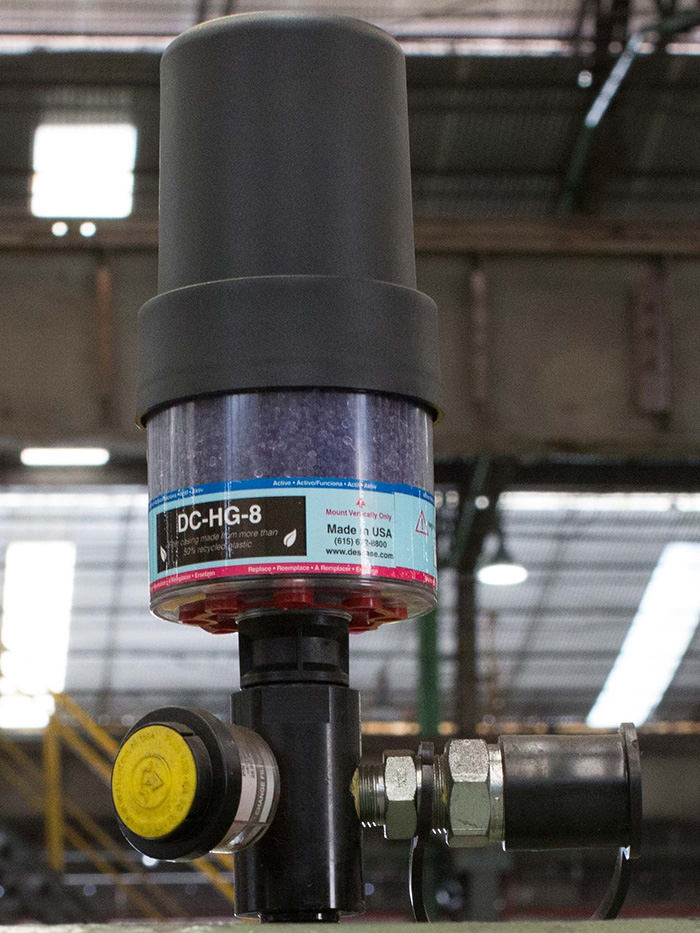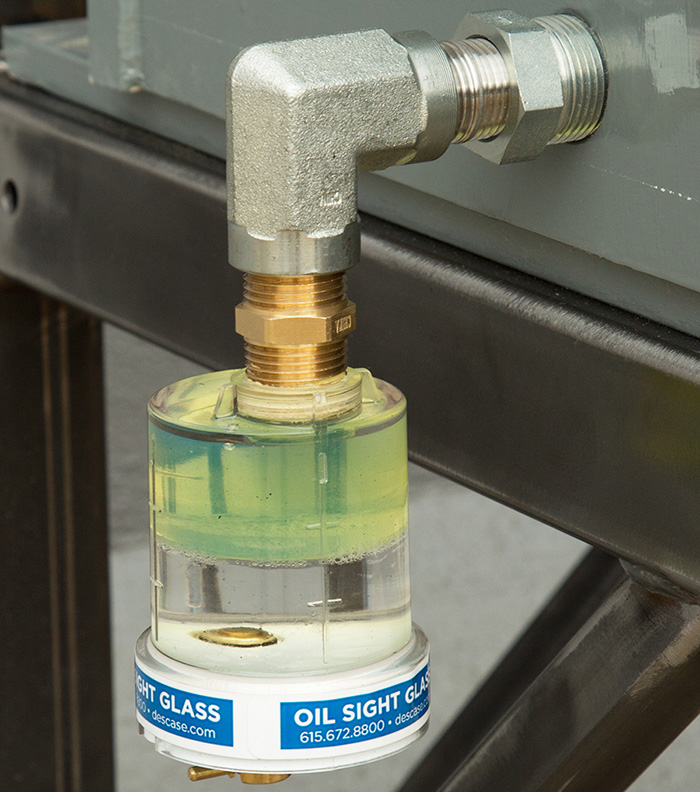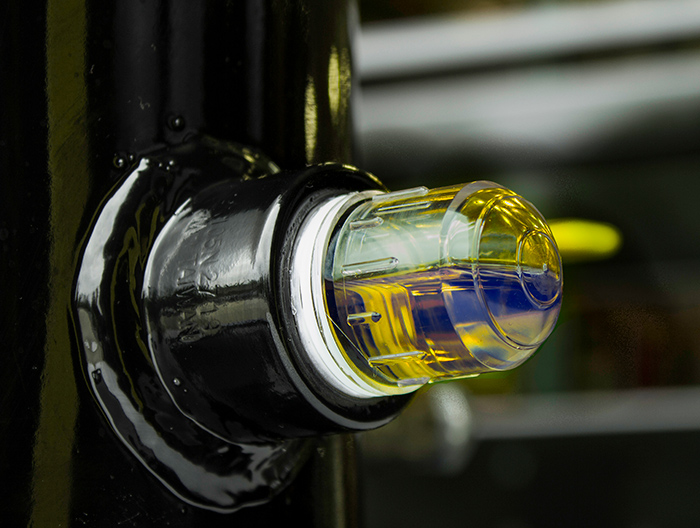While performing unnecessary oil changes is a waste of time and resources, never changing the oil is far worse.
Des-Case Corporation
10/18/2017
Process pumps are often neglected when it comes to precision lubrication. Many maintenance and reliability professionals focus efforts on larger, more expensive machines, but these smaller components can be critical to process reliability, and the cost of repairs can add up. Deploying precision lubrication and contamination-control measures for these applications can reduce repair costs and increase equipment availability. The key to implementing effective lubrication for these assets is optimizing the equipment configuration and lubrication preventive maintenance (PM) procedures. If users choose the right type of sight glass, breather, seals and other accessories, lubrication can be easy and efficient.
Lubricant Selection
The first step in proper lubrication is selecting the right oil. A good oil specification includes three components: base oil type, viscosity grade and additive system type. The most common base oil type is mineral oil, but many choose to use PAO (API group IV) synthetic base oil for longer service life and greater stability under high operating temperatures. The most important part of the specification is the viscosity grade, and most process pumps can operate on a wide range of viscosity grades from ISO VG 32 to ISO VG 100. The most common original equipment manufacturer (OEM) recommendations are for ISO VG 46 and ISO VG 68. Which of these is optimum depends on several factors including operating temperature and the ability to control contamination. If moisture and particle contamination are low or the operating temperature is relatively low, the lower end of the range can be used and will allow for greater efficiency. If the temperature or contamination level are high, the higher end of the viscosity range would be preferable since a thicker oil film will reduce the bearings’ sensitivity to contamination. The last part of the specification is the type of additive system, which could be rust and oxidation inhibited (R&O), anti-wear (AW) or extreme pressure (EP). The most common selection for additive system type is AW, which is often chosen due to the wide use of these products in hydraulic systems. R&O oil may be used as well. EP additives would offer no value in these applications, and EP lubricants in this viscosity range are rare, making them the least common choice.Contamination Control
Proper lubrication also includes keeping the lubricant free of contaminants. The single biggest cause of lost service life in bearings is mechanical wear, and the single biggest cause of mechanical wear is lubricant contamination. Anti-friction bearings are prone to particle induced contact fatigue and even small amounts of water in the oil (greater than 100 parts per million [ppm]) will significantly reduce oil film thickness, increasing the bearing’s sensitivity to particles. Contamination in process pumps can come from three primary sources.New Oil
New oil is usually dry but contains two to 20 times the number of particles acceptable for most lubricated equipment. It must be filtered before use if cleanliness is required for the in-service oil. This problem is theoretically easy to address, but in practice, it can be challenging. The technique used to filter new oil depends on the method of delivery. If it comes in drums, each drum can be filtered using a compact filtration unit such as a filter cart. If the volume is large, the oil can be filtered as it is transferred. Image 1. Use a sealed transfer container and quick connects to protect the oil during transfer. (Images courtesy of Des-Case)
Image 1. Use a sealed transfer container and quick connects to protect the oil during transfer. (Images courtesy of Des-Case)Transfer
Another source of contamination ingress is when the oil is being transferred from the oil container into the pump. Opening the oil transfer container or pump to the ambient operating environment may cause oil cleanliness levels to exceed your target. Instead, oil should be transferred in a sealed container, preferably one that is protected with a breather and has quick connects that mate to quick connects on the pump (see Image 1).In Use
The other primary source of ingression is airborne contamination in the form of particles and humidity that contaminate the oil while in use. Installing a desiccant breather will prevent particulate and moisture from entering the application’s reservoir. It is also capable of removing water from the oil that gets in from other sources by continuously drying air in the headspace. Many plants use high-quality mechanical seals to prevent ingression from the seal and to eliminate the need for a vent on process pumps, but this may not completely eliminate ingression. At the very least, the mechanical seals will breathe while the equipment is shut down allowing significant ingression of humid air for the duration of the outage.Modifying Pumps for Precision Lubrication
Once the new oil is filtered, it must be dispensed, transferred and applied to the machine in a way that won’t reintroduce it to the environment, potentially negating the effort to get the oil clean. Equipment should be modified to remain sealed during all phases of normal operation—including routine maintenance, such as level checks and oil changes. This can be achieved by retrofitting the drain and fill/breather ports with easy-to-install modification kits that permit multiple access points to equipment without opening the sump to the environment. Any modification should allow for topping off the oil, checking the oil level, taking a sample, draining or filling the reservoir, and possibly kidney looping the oil to ensure every lubrication task can be performed without exposing equipment to the dirty plant environment. Image 2. A small case adapter allows for transfer and filtering of the oil through quick connects.
Image 2. A small case adapter allows for transfer and filtering of the oil through quick connects.Adapters
Lubricated equipment doesn’t often come standard with all connections needed to apply desiccant breathers and filtration systems; an adapter can modify the fill port to allow users to transfer or filter oil using quick connects (see Image 2). Using conventional oil transfer equipment such as drum pumps and unsealed oil cans cannot prevent contaminant exposure.Visual Condition Monitoring
Oil sight glasses and other visual oil analysis solutions play a critical role in early detection of contamination and oil level problems. They also allow for constant monitoring of what’s happening inside equipment. The use of bottom sediment and water (BS&W) bowls allows for the draining of gross water contamination and visual level indicators eliminate the need to open the level port to check the level further preventing contamination (see Image 3). Image 3. A BS&W bowl allows for visual detection of the presence of sediment or water.
Image 3. A BS&W bowl allows for visual detection of the presence of sediment or water. PM Optimization
With the proper lubricant specified, every other lubrication activity should be aimed at managing and insuring the condition of the oil. This means controlling contamination, maintaining the correct oil level and changing the oil on time to prevent oxidation or other lubricant degradation. Normally there are only two types of routine lubrication PMs performed on this type of equipment—inspections and oil changes. Routine inspections would ideally be performed daily or even every shift. The focus of the inspection should be to verify the correct oil level and inspect for visual signs of lubricant contamination or degradation. Performing inspections on such short intervals does present challenges, namely manpower and the ability to inspect the items of interest in an efficient manner. To address the issue of manpower, involve operations personnel. It is not necessary to be a journeyman mechanic to perform a basic inspection. With a basic checklist, an operator should be able to perform this task with minimal interruption to operations. They should also have a reporting mechanism to maintenance should corrective action be necessary. The other potential issue is the ability to perform checks in an efficient manner. Without the right accessories, inspection can be cumbersome at best. To quickly and effectively check the oil condition or level, the technician should be able to view the oil easily without having to open the sump. In order for these inspections to have value they need to be performed in seconds rather than minutes. For example, the sight glass should be easy to access, clear (no staining), and provide a large enough sample of the oil to determine its color and clarity. The most effective means of inspecting oil level, color, and clarity is to install a large bullseye-type sight glass that protrudes from the level port and allows the oil to be viewed from 180 degrees (see Image 4). Image 4. A bullseye-type sight glass allows oil to be viewed from virtually any angle.
Image 4. A bullseye-type sight glass allows oil to be viewed from virtually any angle.In Summary
Precision lubrication and contamination control are particularly challenging in small, wet-sump applications like process pumps and gearboxes, which have no onboard filtration. For this reason, it is often necessary to devote more time and care to the lubrication of these lesser assets than the larger more critical machinery that has filtration, oil coolers, temperature and level alarms, etc. With a well-defined program and the right accessories, these assets can get the lubrication they need and facilities can get the reliability they desire.
See other Maintenance Minders articles here.

